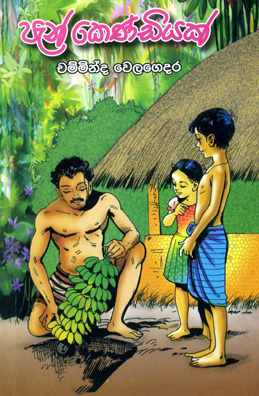Childhood in the village
Paen Kendiyak
Author: Chamminda Welagedara
Publisher: Fast Publishing (Pvt) Ltd
A Surasa book
Reviewed by Kalakeerthi Dr. Edwin Ariyadasa
“One of the luckiest things that can happen to you in life is, I
think, to have a happy childhood”.
Agatha Christie
(1890-1976)
British author
Many ageing men and women have a way of casting nostalgic and longing
retrospective glances at their early childhood.
The fond memories of growing-up years, function as a soothing
counterbalance to their adult anxieties, anguishes and endless
frustrations.
 The careless, unburdened days routinely spent in a childhood world
that basked in a glow of innocence, acquire a keen poignance when viewed
from a grown-up perspective. The careless, unburdened days routinely spent in a childhood world
that basked in a glow of innocence, acquire a keen poignance when viewed
from a grown-up perspective.
Memories of the early days of one's life form an integral facet of
the store of experiences garnered by the average adult human.
Reminiscences
Those in their sunset days – more often than not-preface their
personal reminiscences, with the well-worn cliché “as for our days”. (In
Sinhala ‘a-pe ka-le nam’).
They contrast their own ways as children, with the behavioural styles
of today's young, heaving a deep sigh of nostalgia for those vanished
days.
The generality of adults, who yearn for their childhood days, do not
possess (as a rule) the capacity to articulate coherently, the inner
surges of their sentiments. In brief, they just cannot externalise their
feelings.
In such a backdrop, it is quite pleasing to come upon a work, that
celebrates with undiminished clan, a childhood spent in a traditional
Sri Lankan village.
Taboos
The work chronicles with such impressive detail, the habits, rites,
rituals, mores, customs, ethics, taboos, ceremonies and relationships of
rural culture, that, the book pre-eminently deserves to be classified in
a new category, that can be described as “a work of anthropological
fiction.”
The author of the work-veteran writer Chamminda Welagedara, is
widely-renowned as an award-winning creator of long and short fiction.
He has substantially enriched the idiom of Sinhala prose, through his
apt and effective utilisation of demotic verbal usages.
He titles his work Paen Kendiyak (a decanter of holy water).
In the traditional Sinhala culture, at an auspicious spiritual or
worldly event, water is poured as a blessing, using this kind of
container-kendiya.
At a wedding ceremony an elder blesses the new couple, pouring water
on the joined hands of the bride and the groom.
When a king or any other important individual makes a highly
significant donation of land or any other item, the donor pour water
into the receiver's hand. Kendiya figures prominently at such rituals.
Chronicle
The author has decided to name his work as Paen Kendiyak, I believe,
because he presents ritually, in this work a prestigious chronicle of
our time-honoured rural culture, to his readers.
Landmarks
The fortunes of this village are recorded, as a first-person singular
narration by the protagonist – Sapumal- a pre-adolescent rural youth.
The work opens with a profiling of the landmarks of the protagonists
childhood village.
The primarily juvenile vocabulary, the youthful idiom of expression,
and the unadorned simplicity of narration, taken together exert a
hypnotic hold over the reader – whatever his age-group.
In essence, this is an impressive instance of compelling
story-telling. Immediately on launching into the book, you get involved
with the ups-and-downs in the youthful life of Sapumal.
You begin to savour the spirit that pervades the life-cycle in a
closely-unit rural community as it goes through time-honoured and
tradition-dictated “mudras” of existence.
The unsophisticated rural games that engander a spontaneous glee, in
the unspoilt little psyches of the rural lads, provide a fresh
experience to the readers, who may have known only artificial ways of
life, in areas influenced by waves of cosmopolitanism.
Value
The book possesses a profound value as a tome that captures the
life-spasm of a rural community, reflecting a total empathy with the
rhythm of the day-to-day existence of the rural folk.
The recounting of the rural events acquires a charming liveliness, as
the routines are articulator in the vocabulary of the villagers
themselves.
The book serves as a spectacular commentary of a whole series rural
characters, who seem to have sprung into life from a compendium of
folk-tales.
Their habits and attitude to life, have been viewed by the author,
making comprehensive use of his experience as a fiction-writer of
outstanding achievements.
A serious observer of the parade of life in this rural community,
will invariably be deeply moved by the forces of nature, tradition and
official administration, determine the flow of life in the village.
Presentation
There has never been such a vivid and authentic presentation of an
adolescence, spent in a Sri Lankan rural community with praiseworthy
fictional discipline. He has traced the destiny of his rural community,
synthesising the skills of a seasoned story-teller.
The observation faculties of an anthropologist, who can discern the
significant human detail, in the life of a rural community, that goes
about living, facing dictates that effect them and copying with the
challenges as best as they can. A clearly visible spin-off of this
novel-chronicle, is the interest, it will undoubtedly create in many
discriminating reader, to go to our rural culture and imbibe its unique
flavour-before the relentless urban sprawl overwhelms its identity.
Incidentally, the author has acquired another distinction.
The cinematic version of the of his novels – Sakkaram (sacrifice) was
selected for the final round, in the competitive segment of Bangalary
International Film Festival, held recently in Bangalore, India.
|

